Are isolation exercises necessary, or can you get by with compound exercises?
Based on my 15 years in the fitness industry, I’ve determined that isolation exercises are necessary in three situations.
Quick Answer
- Isolation exercises are necessary for correcting muscular imbalances and rehabilitating injuries.
- They are also helpful for building muscle in particular areas for aesthetic purposes.
- Beginners can get away with using only compound exercises when they first start training.
- An ideal ratio of compound to isolation exercises is 80/20 for most people past the beginner phase.
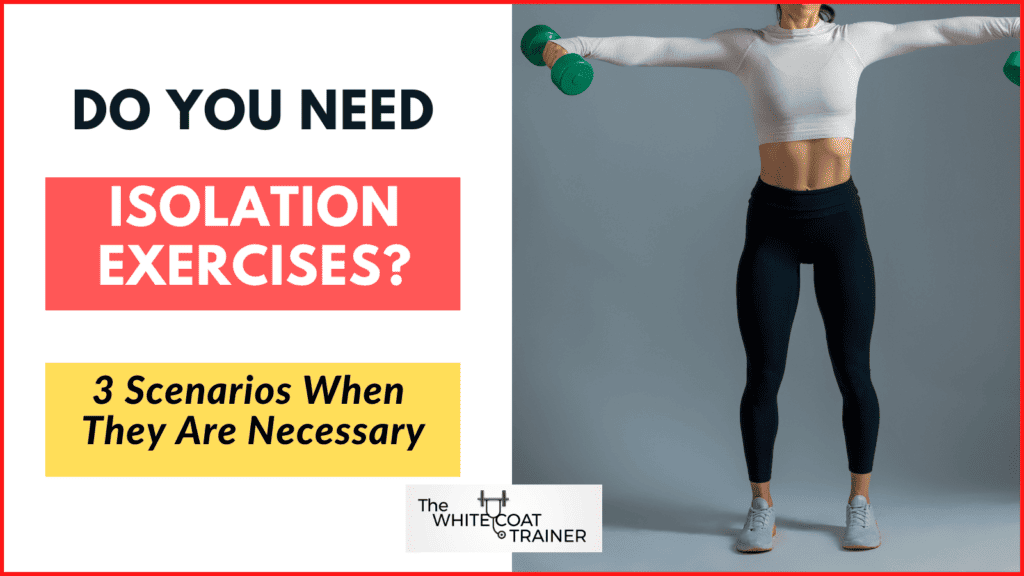
Isolation Vs. Compound Exercises
Isolation exercises are single-joint movements that target one muscle group at a time. Examples include bicep curls, leg extensions, and tricep kickbacks.
Compound exercises are multi-joint movements that work several muscles at the same time. They also tend to replicate movements we do in daily life. Examples include squats, deadlifts, and pull-ups.
Both types of exercises have their benefits, and most people need to use them to maximize results.
Let’s take a closer look.
Who Can Get Away With Not Doing Any Isolation Work?
Beginners and novice lifters do not have to do any isolation work.
As a beginner, you will build muscle and gain strength at a rapid rate. This is why programs like Starting Strength and StrongLifts are super effective.
These programs focus on just five compound lifts. Believe it or not, those five exercises will engage all the major muscle groups in your body.
When I first started training, I only did five lifts.
At The White Coat Trainer, we first tell new clients to focus only on these compound moves.
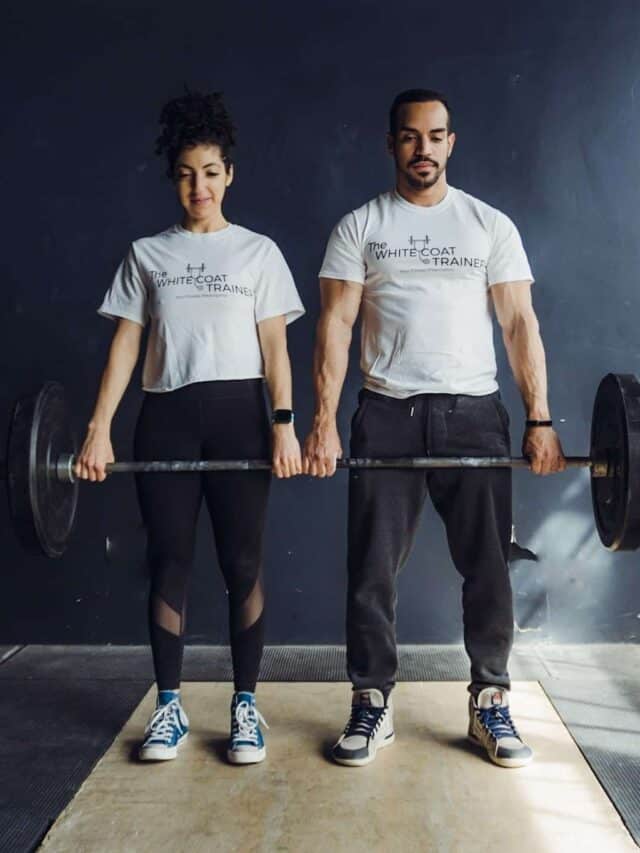
Calisthenics and Isolation Exercises
You can also avoid doing any isolation work if you do calisthenics. Bodyweight exercises are very functional and engage several muscle groups at once.
The nature of these movements also promotes symmetry and balance. As such, the need for focused isolation movements is low in calisthenics.
The Inevitable Need for Isolation
As you get stronger, compound exercises alone won’t be enough to continue progressing.
Most people will develop muscular imbalances or weak points in their career. Unfortunately, compound exercises are not practical for addressing these weak links. Moreover, you may want to build up a specific muscle for aesthetic reasons.
In these situations, isolation exercises become necessary in your fitness journey. They allow you to:
- target specific muscles,
- correct imbalances, and
improve your physique.
Next, let’s discuss the unique advantages isolation lifts have over compounds.
Mini takeaway:
- Compound exercises target several muscle groups at once. Isolations focus on one muscle at a time.
- Beginners can focus on compound lifts only for strength and muscle gains.
- Over time, most lifters will need isolation to address imbalances, aesthetics, or injuries.
The Benefits of Isolation Exercises
They Help Correct Muscular Imbalances
Many people have imbalances where one muscle is stronger than its opposing muscle. For instance, if your hamstrings are weaker than your quads, you may get knee pain while squatting.
The same is true for almost every major muscle group.
Here are the most common imbalances I see in my clients:
- Chest vs. Back
- Anterior vs. Posterior Shoulders
- Quadriceps vs. Hamstrings
- Lower back vs. Abdominals
Neglecting these imbalances can increase your risk of injury over the long term.
Furthermore, compound exercises can worsen these imbalances. When doing complex movements, your body naturally favors the stronger muscle group.
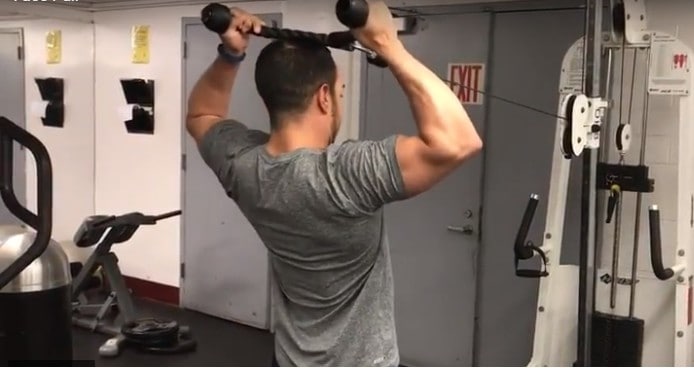
Attacking Weak Points
As you get stronger, you will notice that some muscle groups will respond slower than others. Inevitably, you will develop weak links that can hold you back from progressing.
For example, you might struggle to lock out your bench press due to weak triceps.
In this case, you can add trice-specific exercises to strengthen this area. Common examples include skull crushers or triceps extensions.
Aesthetics
Isolation exercises are also ideal for targeting specific areas for aesthetic purposes. For example, if you want to build bigger biceps, you should do bicep curls.
Similarly, you must perform calf raises if you want more defined calf muscles.
Focusing on a single muscle at a time can maximize muscle mass and build a balanced physique.

Muscle Activation
If you have difficulty activating a specific muscle group, an isolation exercise can help.
For example, let’s say you struggle to feel your glutes working during squats.
You can learn how to fire the glutes by doing single-joint exercises that isolate the glutes. Good examples include the glute bridges or hip thrusts.
The result is better muscle recruitment during more complex exercises like squats.
Rehabilitation
Isolation exercises can also be valuable in rehab if you are recovering from an injury.
They allow you to focus on strengthening the muscle groups around your injured joint.
Compound exercises can make it difficult to isolate the injured area. More often than not, complex movements can place unnecessary stress on your injury.
The Cons of Isolation Exercises
They Are Less Functional
Compound movements mimic everyday activities and are, by default, functional.
For example:
- Squats replicate sitting down and standing up.
- Deadlifts replicate picking up objects from the ground.
- Pull-ups replicate pulling yourself up from a ledge.
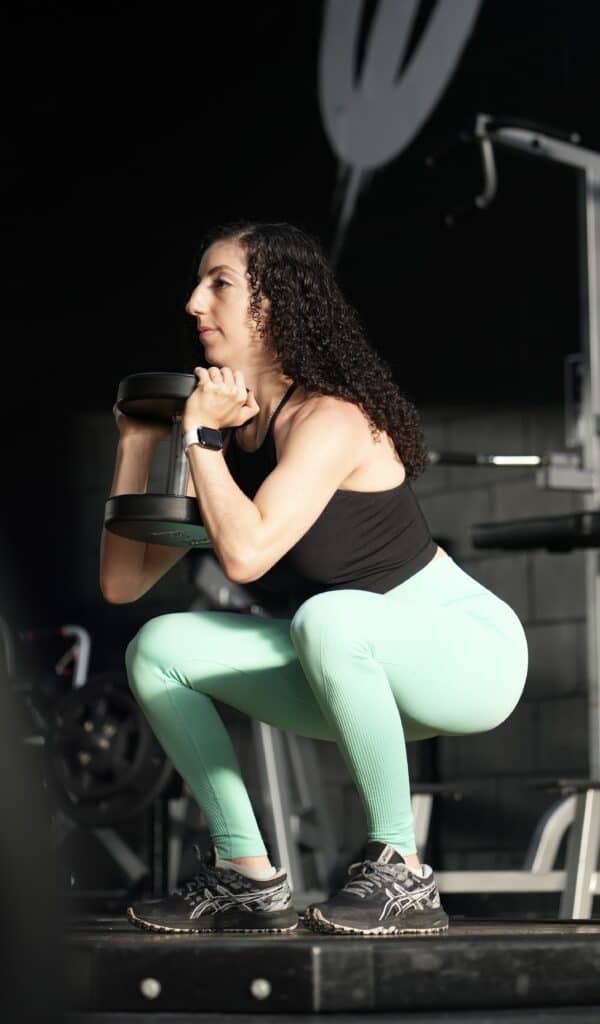
Isolation exercises do not transfer as well to daily life movements. Think about it: they don’t resemble anything you do outside the gym.
In real life, almost all human movements need dozens of muscles to work together.
They Are Time-Consuming
If you are short on time, there are more efficient ways to work out than isolating each body part. You would need to do several exercises to target all the muscle groups in the body.
As such, you will have to spend much more time in the gym to get a well-rounded workout.
Compound movements can target 80% or more of your muscles with just five lifts.
Mini takeaway:
- Isolation targets individual muscles, while compounds engage many muscles in functional, real-world movements.
- Isolations can correct imbalances, attack weak points, build symmetric muscles, and rehab injuries.
- Isolations are less functional for real-life activities and more time-consuming than compound lifts.
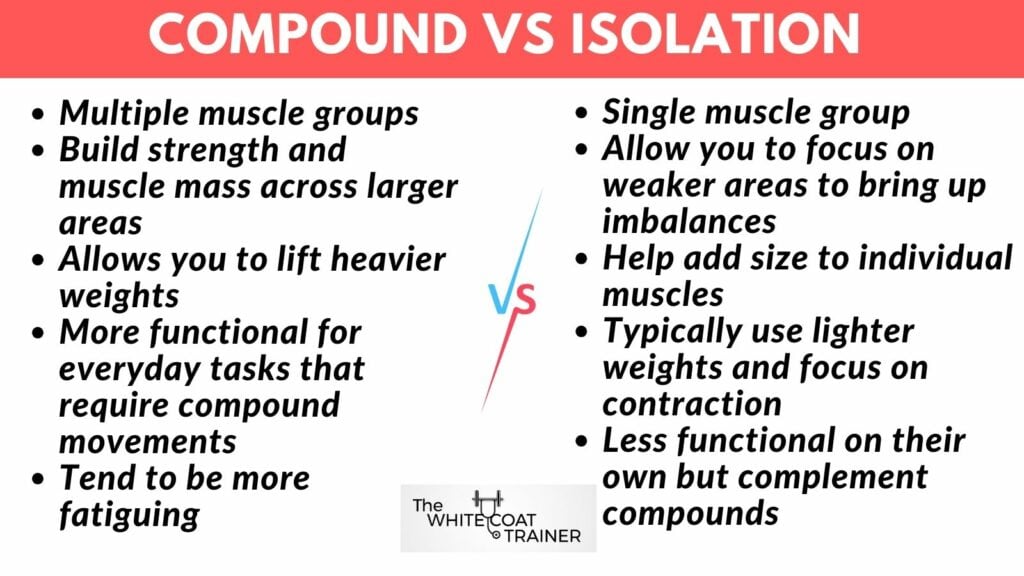
Designing Your Workout: When to Use Isolation Exercises
There are four scenarios where you should add isolation exercises into your routine.
#1 You Want To Target Specific Muscle Groups
Isolation exercises are necessary to maximize a muscle’s hypertrophy (muscle growth). Common examples include the biceps, triceps, or calf muscles.
This scenario is typical for bodybuilders trying to sculpt a specific area in the body.
Sure, heavy compound moves will stimulate smaller muscle groups, but not enough. Isolations are necessary to achieve peak muscle size and definition.
Compound exercises lay the foundation, and isolation exercises fill the intricate details.

#2 You Need To Fix Muscular Imbalances
As mentioned earlier, imbalances can lead to chronic pain and injuries. If you have an imbalance, you must focus on isolation exercises to target the weaker muscle group.
For example, let’s say you have shoulder pain while bench pressing. Assuming you have good technique, you more than likely have a muscular imbalance.
In this case, consider adding more posterior shoulder isolation exercises. Examples include face pulls and external rotations.
#3 You Have Injuries Or Need Rehabilitation
If you have an injury, isolation exercises can help you stay active while resting the injury. They also let you strengthen the muscles around the injury without aggravating it further.
A typical example is a knee injury. While recovering, you can isolate the musculature surrounding the knee joint.
You can train
- The tibialis muscle, by doing tibialis raises,
- Calves by doing calf raises,
- The gluteus medius with hip abductions,
- The quadriceps (especially the VMO) with terminal leg extensions
Bonus: Overuse and Deloading
Moreover, another good time to consider isolation exercises is when you need rest. Heavy compound lifting can beat you up over time, leaving you achy, sore, and tired.
Thankfully, you can continue your training routine with a much lighter intensity.
I recommend that my clients take a deload week every four to six weeks of training to allow the body to recover. Isolation movements can keep your body active with reduced stress during this time.
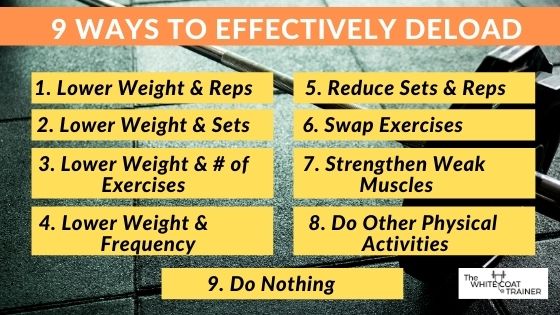
#4 You Are Experiencing Plateaus
If you have been lifting for a while, you likely have experienced a strength plateau. In other words, a specific compound exercise begins to stall, and you stop making progress.
The next step is to identify if you have a weak link that is holding you back.
For example, let’s say you are stuck at a certain weight on your bench press. You may have no problem getting the weight off your chest, but you may struggle to lock the weight out.
In this case, your triceps may be the weak point.
One approach is to add a more tricep-dominant compound exercise. The close-grip bench press is an obvious answer. But the problem with this approach is that you might also need a break from the bench press movement.
The second option is to add tricep-specific isolation exercises. The advantage is that you can stimulate the triceps while using lighter loads. The end result is stronger triceps and less stress on your joints.
Mini takeaway:
- Incorporate isolation exercises when
- targeting specific muscles for shaping or hypertrophy goals,
- correcting muscular imbalances that cause pain/injury,
- rehabilitating injuries by strengthening surrounding muscles,
- or strengthening weak points to break through plateaus on compound lifts.
Other Times To Consider Using Them In Your Training
Muscular Activation and Awareness
Learning how to activate muscles is a crucial aspect of fitness training.
This phenomenon is the “mind-muscle connection.” In other words, it is the ability to consciously engage specific muscles in training.
Isolation exercises are the best way to enhance your mind-muscle connection.
The best exercise to see this in action is the banded hip abduction. There is no way not to feel your glute muscles firing when doing this exercise.
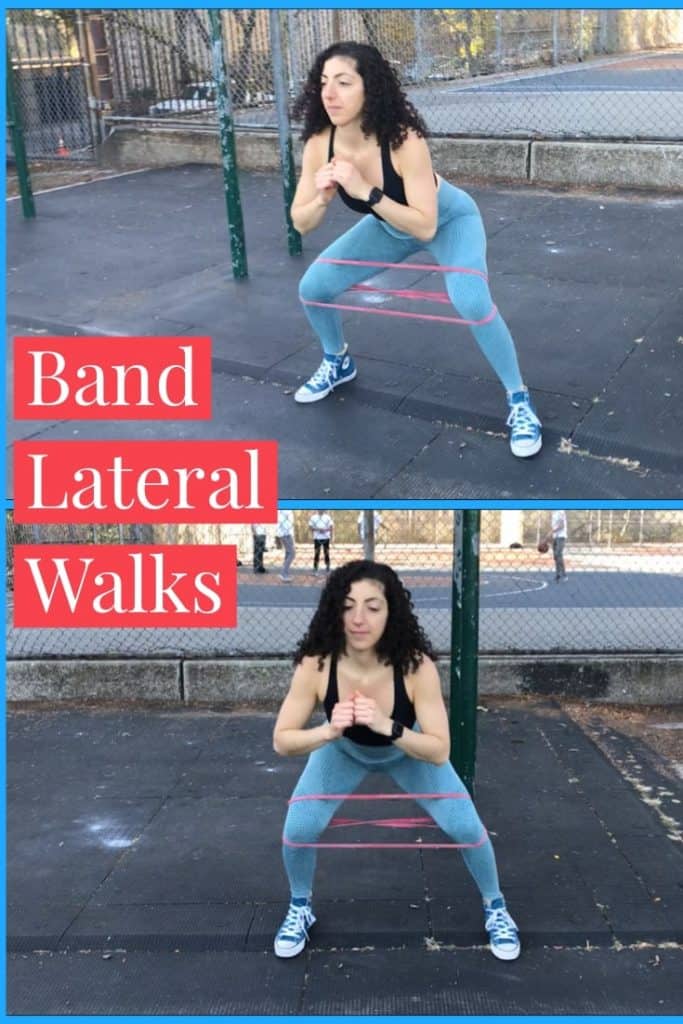
When trying to activate a muscle, try to focus your attention on the specific muscle that is working. Feel the muscle contract and elongate during the concentric and eccentric.
Every muscle group has a unique sensation when firing.
Preventing Future Injuries
Rehab aside, doing isolation exercises can also help prevent future injuries.
Keeping these auxiliary muscles strong makes you less likely to experience muscular imbalances.
This proactive approach to training can help you avoid injury due to weak or underused areas.
Mini takeaway:
- Isolation exercises can also improve mind-muscle connection and help prevent future injuries.
- They also allow you to maintain a training effect while reducing stress on your joints.
- Isolation can strengthen weak points that are limiting your progress on compound lifts.
Examples of Isolation Exercises for Each Muscle Group
Here is a list of the most common isolation exercises
- Bicep Curls: With dumbbells, barbells, cables, or bands
- Tricep Extensions: Overhead or lying down with dumbbells, cables, or machine
- Leg Extension: On a machine
- Hamstring Curls: While lying prone or seated at a machine
- Calf Raises: From a standing position or seated
- Lateral Raises: Hold dumbbells at your sides and lift your arms straight out to the sides. These target the medial shoulders aka lateral deltoids.
- Chest Flys: On a flat bench with dumbbells or on a machine
- Rear Delt Flys: Dumbbells or on a machine
- Leg Abductors/Adductors: On a machine
- Wrist Curls: With dumbbells or barbells
How To Put It All Together
Now that we know when to use isolation moves let’s discuss how I integrate them into a client’s routine. Here’s a checklist you can ask yourself.
- Identify Your Objectives: Determine your primary fitness objectives. Are you aiming for strength gains, muscle hypertrophy, aesthetics, or injury rehabilitation? Knowing your goal is crucial for deciding the role of isolation moves in your routine.
- Tailor Your Approach:
- For Strength: Compound exercises should make up the majority of your workout. Approximately 80%. Beginners can use 100% compound exercises to build a solid foundation.
- For Aesthetics: If you want to achieve a specific look, you must spend more time isolating. Focus on doing at least six sets per week on the muscle groups that need aesthetic enhancements. The same is true for hypertrophy.
- Injury: If you need to rehab an injury or address an imbalance, spend 50% or more of your time on isolation.
- Balancing Compound and Isolation Movements:
- Ratio Consideration: As a guideline, aim for an 80/20 ratio of compound to isolation exercises. This ratio gives you a good balance of efficiency and functionality.
- Strategic Placement: I tell my clients to do isolation exercises after compound movements. This approach allows you to do the harder exercises first while you are still fresh. Another option is to do isolation moves first as a “warm-up” for the heavier lifts.
- Progressive Overload and Variation: Always look for ways to progress your training. You can do this by increasing the resistance or intensity of your lifts in a gradual manner. Additionally, you can vary your exercises every 8 weeks to prevent plateaus.
Conclusion
Isolation exercises have their place in a well-rounded workout routine. In general, beginners can focus only on compound moves.
As you become more advanced, you should do more exercises that work one muscle at a time.
Four key situations that need isolation exercises include:
- correcting a muscle imbalance,
- strengthening lagging muscle groups,
- enhancing aesthetics and
- rehabilitating injuries.
You can also use them to help break plateaus and improve mind-muscle connections.
Now, how often will you include isolation lifts in your training sessions?

Alex Robles, MD, CPT / Brittany Robles, MD, MPH, CPT
Alex & Brittany Robles are physicians, NASM Certified Personal Trainers, and founders of The White Coat Trainer: a resource dedicated to improving the health and fitness of busy professionals using time-efficient strategies. Their advice has been featured in My Fitness Pal, Prevention, Livestrong, Reader’s Digest, Bustle, The Active Times, and more. Learn more about them here.
